Steam ships from the Crimean War
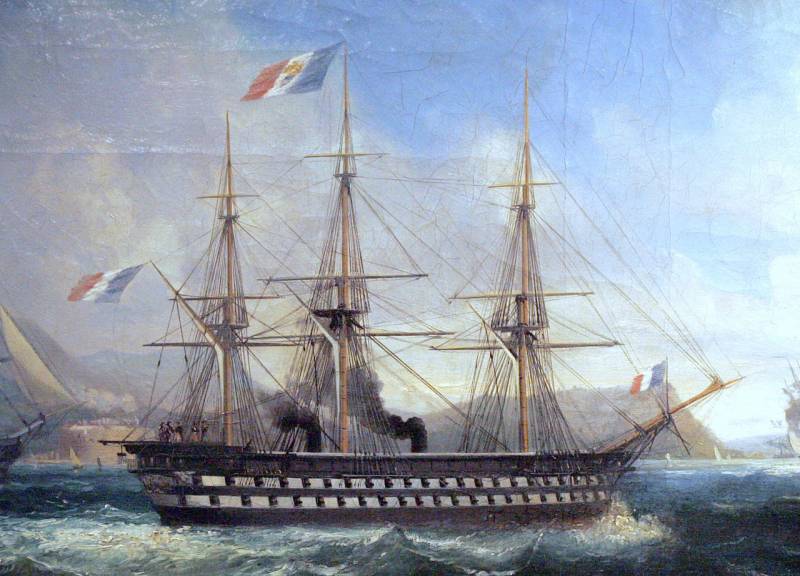
On March 27, 1854, England and France declared war on Russia, and the Crimean War began. Since both powers had no land border with Russia, actions came to the fore fleet. In Russian-language literature there is an opinion that sailing ships had no chance against steam ships. Why? Well, just like that. We are asked to take this on faith.
Let's try to figure out what the Allied steam ships were like at that time.
Sail or steam?
Let's start with historical references.
In 1801, the paddle-wheeled steam ship Charlotte Dundas sailed the Clyde Canal against the wind for the first time. In 1812 the ship Themes covered the distance from Greenlock to London. In 1819 the steamship Savanah crossed the Atlantic. But for the time being, the steamships did not go into production - they had too many childhood diseases, common at the stage of crude technology.
So, in 1825, Thomas Cochrane ordered five steam corvettes for the Greek fleet, but within a year the English shipyards were able to build only one, moreover, before reaching Greece, the corvette changed from a steam corvette to a sailing corvette - the explosion of the boilers damaged the car so much that it was out of order . All five corvettes had constant problems with their boilers and spent more time undergoing repairs than sailing. As a result, the Greeks believed that they had thrown money away.
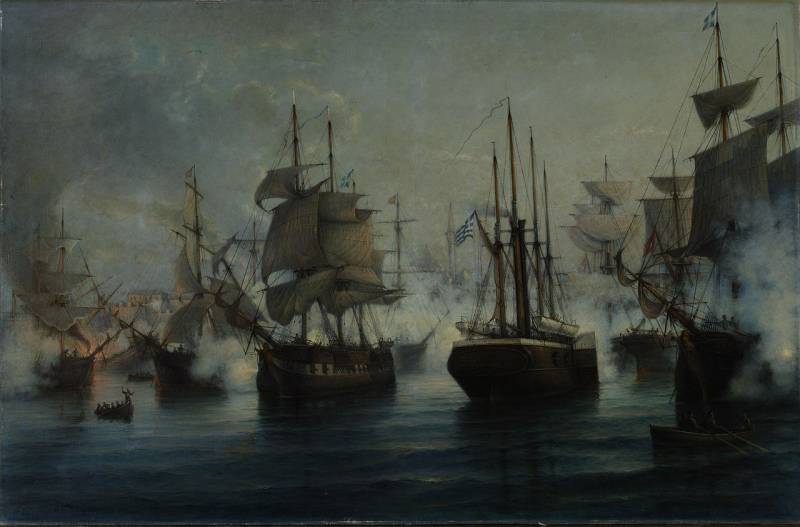
Greek steam corvette Kartería at the Battle of Itea.
In the 1820s and 1830s, sailing battleships and frigates continued to be the basis of the fleet. In England all this time there were disputes between supporters of the “young school” and “traditionalists”: the former believed that the fleet should switch to steam as quickly as possible, the latter said that wind, sails and the testaments of antiquity are quite enough, and all these steamships of yours are possible only on calm rivers and lakes, because in the sea, due to waves, all these paddle wheels and propellers simply cannot work.
To resolve this dispute, in 1844, the chief surveyor of the fleet, William Symonds, on his own initiative, created an “experimental squadron” of steam ships, which made several cruises around England and proved that steam ships were quite seaworthy.
The First Lord, who was then Edward Law, Earl of Ellenborough, a “traditionalist,” demanded that Symonds stop his experiments, but the surveyor did not pay attention to these demands. As a result, in 1848 he was dismissed.
In the same year, the Principal Storekeeper of the Ordnance, Thomas Hastings, proposed converting one of the old 74-guns - installing a steam engine there, sawing off the masts and using it as a self-propelled battery to defend Sheerness. The experience turned out to be successful, and to protect Portsmouth, Hastings proposed reformatting 4 more battleships and 6 frigates in the same vein.
Actually, this is how the famous English blockships appeared - the 60-gun Blenheim, Ajax, Hogue and Edinburgh. 200 thousand pounds were spent on their conversion, and all the ships turned out to be slow-moving, with a speed of 450–4 knots on a low-power steam engine (5 hp), and no more than 6 knots with sails.
Since the ships were being redesigned and not created according to the project, it was necessary to remove some of the guns, reduce the size of the provisions and water accepted, etc. As a result, the supply of coal on the blockships was calculated for exactly 4 days, and the reserve of provisions and water, instead of six months, was loaded only for two month.
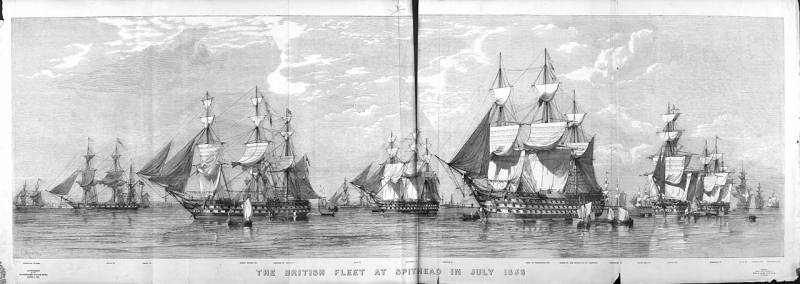
Review of the English fleet at Spithead, August 1853.
A separate problem was vibration, which was present in all models of steam battleships of the 1840s. Because of it, the accuracy of artillery fire was greatly reduced; “traditionalists” more than once reproached this to representatives of the “young school” who advocated the widespread transfer of battleships to steam. Like, if warships are created for combat, then how will they shoot when it is impossible to aim due to vibration? It turns out that in battle our newest screw ships again become... sailing.
The solution was complex, from the mathematical calculation of the lengths and curvature of the blades to the scientific method. In 1851, the Admiralty's experiments to get rid of vibration ended in relative success - it was not possible to get rid of vibration completely, but it was greatly reduced.
It would seem that the project was unsuccessful, but in 1855 the British converted 5 more battleships using the same principle - Russell, Cornwallis, Hawke, Pembroke and Hastings. In the Crimean War, only HMS Pembroke was able to distinguish itself in sinking ships - it accidentally rammed and sank the English merchant brig Lady Sale off the Isle of May.
Actually, the French did the same thing, converting sailing ships into steam ones; they called such conversions with low-power machines mixte.
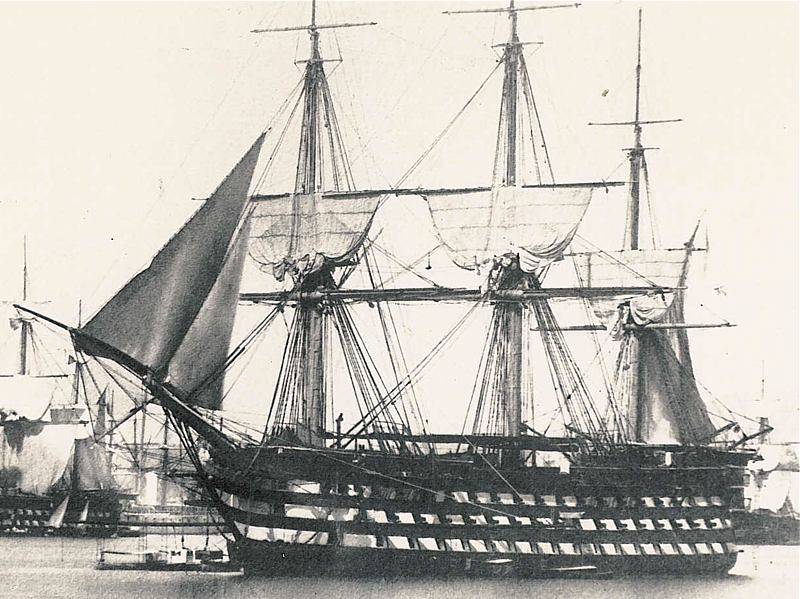
French 130-gun ship Montebello, later converted into a steam ship.
It was only in the 1850s that it was understood that a full-fledged steam propeller-driven battleship had to be built from scratch, and a ship design had to be developed, with space for a vehicle, for coal, for supplies and weapons. As a result, the first full-fledged steam battleships entered service only in 1851–1852; in the English fleet these were Sans Pareil and Agamemnon. But... on both ships they again installed weak engines, 550 and 600 hp. With. accordingly, therefore their speed did not exceed 7,5 knots.
In 1850, the French launched the first full-fledged steam screw battleship Napoleon, and it was essentially the only normal ship the Allies had in the Crimean War - a 960-horsepower machine. sec., speed 12 knots, coal supply for 9 days at full speed, provisions reserve for 3 months.
But even in 1853–1854, steam ships and steam engines were very crude, and the basis of all fleets was still sailing ships.
Tactics of use
Let us give an example.
On October 22, 1853, the screw ships of the British and French, having raised anchors, tried to sail up the Dardanelles Strait, with sailing battleships in tow. But they were disappointed. Charlemagne (120 horsepower machine) with Valmy in tow found the opposing current so strong that it stopped towing even before it passed through the strait. The British screw ship of the line Sans Pareil (500 horsepower) attempted to tow the collier but also failed.
Only two towing attempts were successful: the most powerful (650 hp) in the French fleet, the wheeled steam frigate Homere towed Iéna - although very slowly.
Also, the newest screw battleship Napoleon (960 horsepower), taking the French flagship Ville de Paris in tow, crossed the strait with impressive ease, leaving behind most of the French and all the British ships. As a result, the Allies had to wait for favorable winds to enter the Bosporus.
The surface current in the Dardanelles is only 4 knots, but, as we see, it has become insurmountable for most of the steam ships of the allied squadron. Yes, of course, these steam ships were weighed down by tugs, but still.
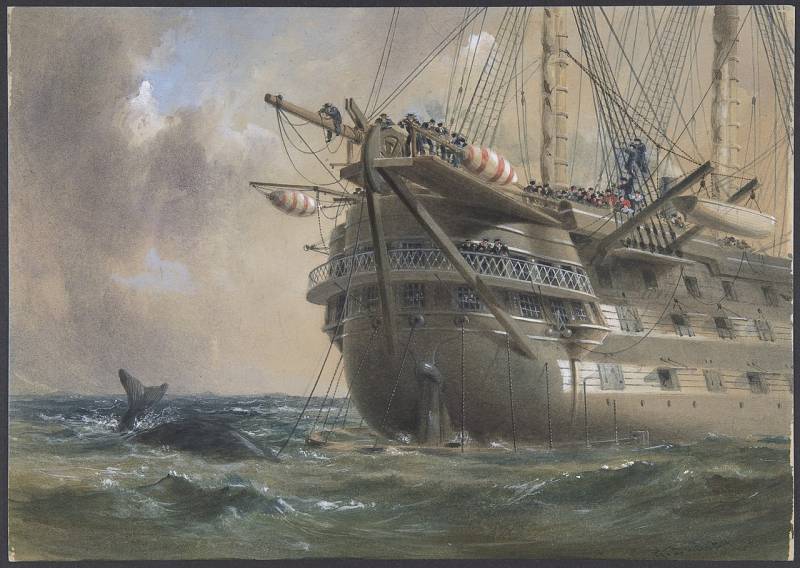
HMS Agamemnon.
In total, the Allies in the Black Sea in 1854 had five screw battleships - these are three full-fledged battleships: Napoleon, Sans Pareil and Agamemnon, and two mixte: Charlemagne (120 hp) and Montebello (140 hp). The remaining Allied ships were sailing ships.
How were steam battleships supposed to be used in a hypothetical battle?
Oddly enough - but with the car turned off and under sail. Maneuvers on the Spithead roadstead in August 1853 showed that to successfully capture the enemy’s head or cut a line, not individual screw battleships are needed, but a fleet of screw battleships, since the bulk of sailing ships simply do not have time to come to their aid.
That is why Solomon’s decision was made - the speed of the squadron is determined by the speed of the slowest ship, therefore... it will use steam ships as sailing ships as part of a sailing squadron. They only need a steam engine on the transition to battle.
The Baltics
So, as we found out, the Allies sent only five screw battleships to the Black Sea. What was sent to the Baltic?
Composition of the Anglo-French squadron (LC only):
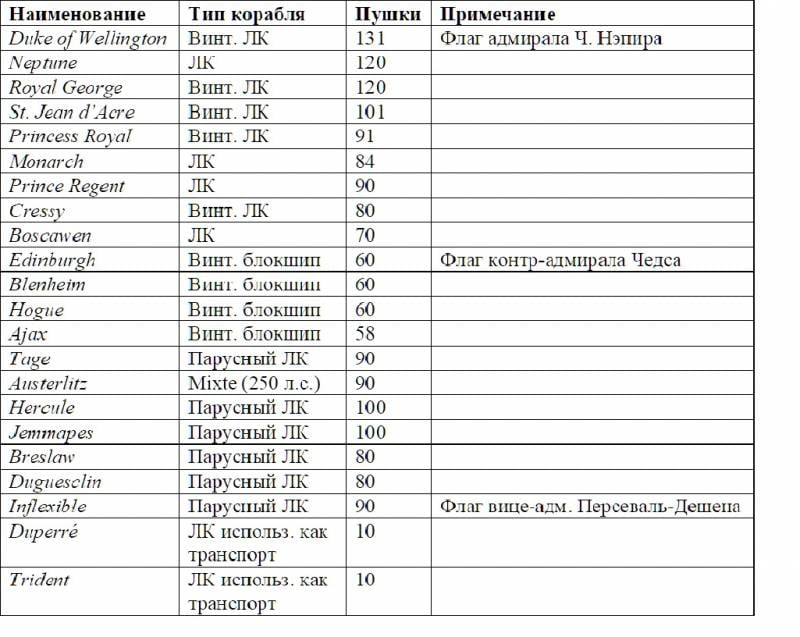
As you can see, there is a much larger number of propeller battleships here. But, if we carefully study the composition, we again see problems.
Firstly, 4 blockships, which we have already talked about, and one mixte with a weak car were inserted into the outfit.
120-gun Royal George - converted, but the number of guns had to be reduced to 89, coal was stowed on the accommodation deck, and the water supply was reduced to two weeks. After the conversion, the ship turned out to be so bad that even before the end of the Crimean War in 1856, it was converted into a troop transport.
The 91-gun Princess Royal is also a conversion. There was a supply of coal for exactly two days, the speed did not exceed 6 knots.
The 131-gun Duke of Wellington was originally built as a sailing ship, but then the design was changed and the ship was converted into a steam-powered one. A fairly powerful engine (780 hp) was installed on the ship, which turned out to be unreliable, its boilers constantly failed, so in the 1854 campaign the ship was used as a sailing ship, and in 1856 it was generally laid up for a long time in Devonport .
That is, of the English squadron, only St. was a full-fledged ship. Jean d'Acre and Cressy, all other battleships had big problems as steam ships.
Some conclusions
Despite the presence of a large number of steam battleships among the British and French during the Crimean War, the technology of steam engines had not yet been fully developed, it was simply crude. Some of the ships were converted sailing ships, on which weak-powered vehicles were installed, and due to a reduction in armament, a reduction in supplies of food and water, and a densification of the deployment of personnel.

French steam battleship Napoleon.
These ships were not full-fledged combat steam ships, but, most likely, an attempt to somehow plug one or another gap in the admirals’ considerations. In battle, steam battleships were supposed to be used as ordinary sailing ships; they started talking about creating separate detachments of steam ships only after the Crimean War.
Well, a separate question - did the Russian sailors know about these problems?
The answer will be simple - yes, they knew. At the same maneuvers on the Speedhead roadstead, captain (future admiral) Butakov was present as an observer; the problems and childhood illnesses of steam ships were widely discussed in the English and French press (in particular in the Times), moreover, at the expert level, this is all studied by Russian representatives in England who were involved in the purchase of ships.
Moreover, it was during the Crimean War that steam ships found themselves in the conditions of real combat operations, all the difficulties of the Baltic and Black Sea navigation; in fact, in the conditions of a real war, their machines and engineering systems experienced failure.
And most of the problems and diseases of steam ships were corrected only by 1857, that is, after the Crimean War, and the very tactics of using steam ships were developed only in 1859.
Why didn’t Russian captains and admirals decide to fight a decisive battle either in the Black Sea or in the Baltic?
But we will leave this question unanswered, let everyone draw their own conclusions.
References:
1. Hamilton C. A. “Anglo-French naval rivalry, 1840–1870” - Military literature (militera.lib.ru), 2006.
2. Brereton V.M. “The British Fleet in the Black Sea” - London, 1856.
3. Baumgart, Winfried. "The Crimean War, 1853–1856" - London, UK and New York: Oxford University Press, 1999.
4. Chevalier, Louis E. “Histoire de la Marine Française de 1815 a 1870” – Paris, France, Librairie Hachette et Companie, 1900.
5. Clowes, Sir William Laird. “The Royal Navy: A History from the Earliest Times to the Present” (7 Volumes) – London, UK: Sampson, Low, Marston and Co., 1897–1903 [Volume VI: 1901].
6. Lambert, Andrew D. “The Crimean War. British Grand Strategy Against Russia, 1853–1856" - Manchester, UK: Manchester University Press, 1991.
7. Tritten JJ “A Doctrine Reader: The Navies of the United States, Great Britain, France, Italy, and Spain” - “Naval War College Newport Papers”, 2012.
8. Brown DK “Royal Navy in the Crimean war: technological advances” - “Colloque International Marine et Technique”, Paris, June, 1987.
Information